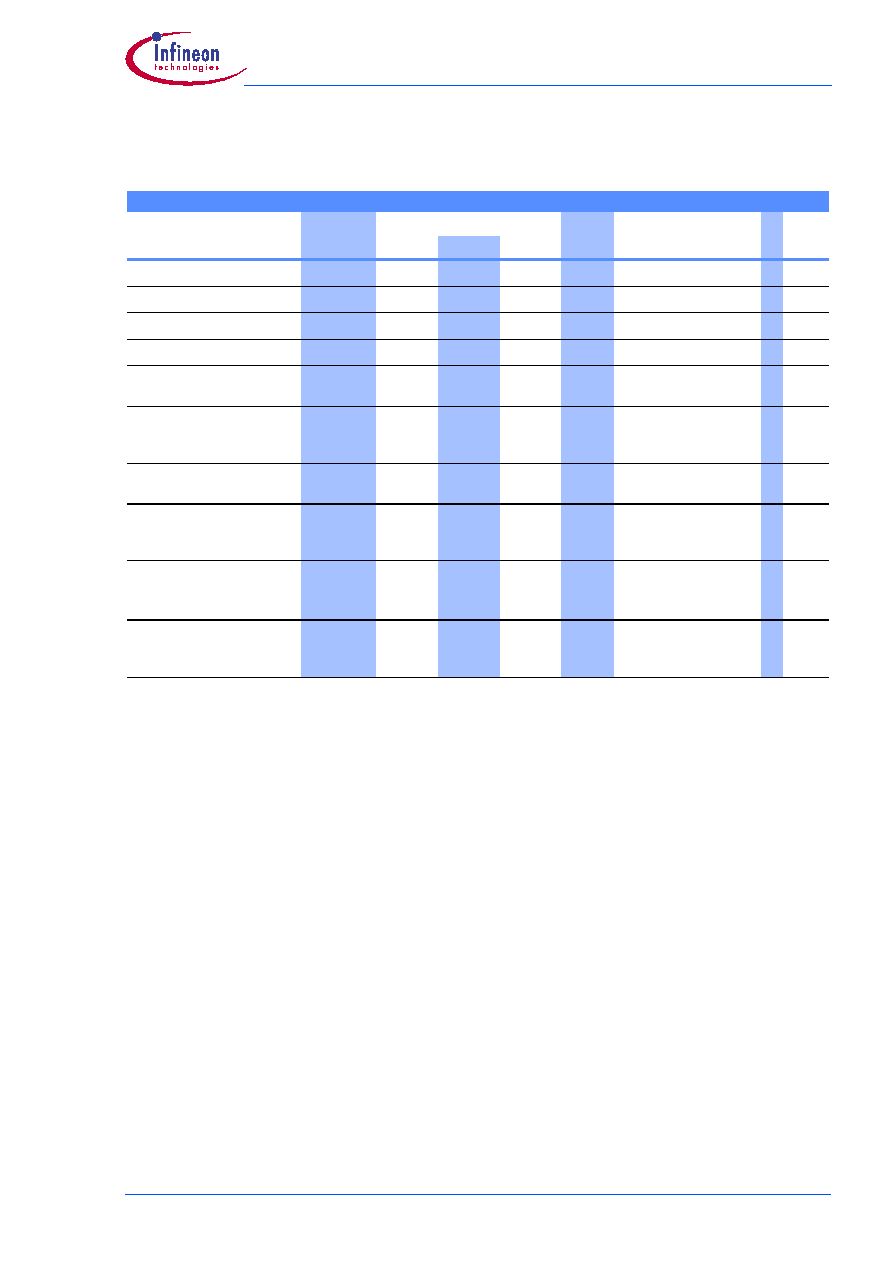- 您現(xiàn)在的位置:買(mǎi)賣(mài)IC網(wǎng) > PDF目錄98304 > TUA6032 (INFINEON TECHNOLOGIES AG) 3-BAND, VIDEO TUNER, PDSO38 PDF資料下載
參數(shù)資料
| 型號(hào): | TUA6032 |
| 廠(chǎng)商: | INFINEON TECHNOLOGIES AG |
| 元件分類(lèi): | 調(diào)諧器 |
| 英文描述: | 3-BAND, VIDEO TUNER, PDSO38 |
| 封裝: | PLASTIC, TSSOP-38 |
| 文件頁(yè)數(shù): | 31/49頁(yè) |
| 文件大?。?/td> | 882K |
| 代理商: | TUA6032 |
第1頁(yè)第2頁(yè)第3頁(yè)第4頁(yè)第5頁(yè)第6頁(yè)第7頁(yè)第8頁(yè)第9頁(yè)第10頁(yè)第11頁(yè)第12頁(yè)第13頁(yè)第14頁(yè)第15頁(yè)第16頁(yè)第17頁(yè)第18頁(yè)第19頁(yè)第20頁(yè)第21頁(yè)第22頁(yè)第23頁(yè)第24頁(yè)第25頁(yè)第26頁(yè)第27頁(yè)第28頁(yè)第29頁(yè)第30頁(yè)當(dāng)前第31頁(yè)第32頁(yè)第33頁(yè)第34頁(yè)第35頁(yè)第36頁(yè)第37頁(yè)第38頁(yè)第39頁(yè)第40頁(yè)第41頁(yè)第42頁(yè)第43頁(yè)第44頁(yè)第45頁(yè)第46頁(yè)第47頁(yè)第48頁(yè)第49頁(yè)

Reference
5 - 37
TUA6030, TUA6032
Wireless Components
Specification, January 2002
Table 5-3 AC/DC Characteristics with TAMB = 25 °C, VCC = 5VC (continued)
Symbol
Limit Values
Unit
Test Conditions
LItem
min
typ
max
Source current 1
AGCfast
7.2
9.0
10.8
A
Source current 2
AGCslow
185
220
264
nA
Peak sink to ground
AGCpeak
80
100
120
A
AGC output voltage
VAGCmax
3.3
3.5
3.7
V
maximum level
AGC output voltage
VAGCmin
0
0.25
V
minimum level
RF voltage range to
switch the AGC from
active to inactive mode
AGCSLIP
0.5
dB
AGC output voltage
AGCRML
0
2.9
V
AGC bit high or AGC
active
AGC output voltage
AGCRMH
3
3.5
VCC-
0.5
or 4
V
AGC bit low or AGC
inactive
AGC leakage current
AGCLEAK
-50
50
nA
AL2, AL1, AL0 =
1,1,0
0 < VAGC < VCC
AGC output voltage
AGCOFF
3.3
3.5
VCC-
0.5
or 4
V
AL2, AL1, AL0 =
1,1,1
AGC is disabled
s This value is only guaranteed in lab.
1). The RF frequency range is defined by the oscillator frequency range and the intermediate frequency (IF).
2). This is the level of the RF unwanted signal (50% amplitude modulated with 1kHz) that causes a 1.1 kHz
FM modulation of the local oscillator and thus of the wanted signal; Vwanted = 100 dBV; funwanted = fwanted +
5.5 MHz.
3). Local oscillator FM modulation resulting from I2C communication is measured at the IF output using a mod-
ulation analyser with a peak to peak detector ((P+ +P-)/2) and a post detection filter 30 Hz - 200 kHz. The I
2C
messages are sent to the tuner in such a way that the tuner is addressed but the content of the PLL registers
are not altered. The refresh interval between each data set shall be 20 ms to 1s.
4). This is the level of the RF signal (100% amplitude modulated with 11.89 kHz) that causes a 750 Hz fre-
quency deviation on the oscillator signal producing sidebands 30 dB below the level of the oscillator signal.
5). Channel S02 beat is the interfering product of fRFpix, fIF and fOSC of channel S02, fBEAT = 37.35 MHz. The
possible mechanisms are fOSC - 2 x fIF or 2 x fRFpix - fOSC.
6). Channel A-5 beat is the interfering product of fRFpix, fIF and fOSC of channel A-5; fBEAT= 45.5 MHz. The pos-
sible mechanisms are: fOSC - 2 x fIF or 2 x fRFpix - fOSC.
7). Channel 6 beat is the interfering product of fRFpix + fRFsnd - fOSC of channel 6 at 42 MHz.
8). The IF output signal stays stable within the range of the fref step for a low level RF input up to 120 dBV.
9). N+5 -1 MHz is defined as the input level of channel N+5, at frequency 1 MHz lower, causing FM sidebands
30 dB below the wanted carrier.
10). Limits are related to the tank circuit used in the application board (Chapter 4). Frequency bands may be
adjusted by the choice of external components.
11). The frequency shift is defined as a change in oscillator frequency when the supply voltage varies from
VCC = 5 to 4.75 V (4.5 V) or from VCC = 5 to 5.25 V (5.5 V). The oscillator is free running during this measure-
ment.
12). The frequency drift is defined as a change in oscillator frequency if the ambient temperature varies from
Tamb = 25 to 50 °C or from Tamb = 25 to 0 °C. The oscillator is free running during this measurement.
相關(guān)PDF資料 |
PDF描述 |
|---|---|
| TUA6030 | 3-BAND, VIDEO TUNER, PDSO38 |
| TUA6034-T | 3-BAND, VIDEO TUNER, PDSO38 |
| TUA6034-V | 3-BAND, VIDEO TUNER, QCC48 |
| TUA6036-T | 3-BAND, VIDEO TUNER, PDSO38 |
| TUA6039F-2 | 3-BAND, VIDEO TUNER, QCC48 |
相關(guān)代理商/技術(shù)參數(shù) |
參數(shù)描述 |
|---|---|
| TUA6034 | 制造商:INFINEON 制造商全稱(chēng):Infineon Technologies AG 功能描述:3-Band Digital TV / Set-Top-Box Tuner IC TAIFUN |
| TUA6034_06 | 制造商:INFINEON 制造商全稱(chēng):Infineon Technologies AG 功能描述:3-Band Digital TV / Set-Top-Box Tuner IC TAIFUN |
| TUA6034DEMOBOARD | 制造商:Infineon Technologies AG 功能描述: |
| TUA6034-T | 制造商:INFINEON 制造商全稱(chēng):Infineon Technologies AG 功能描述:3-Band Digital TV / Set-Top-Box Tuner IC TAIFUN |
| TUA6034TCUMA1 | 制造商:Infineon Technologies AG 功能描述:Tuners PAL/NTSC 863.25MHz 38-Pin TSSOP 制造商:Infineon Technologies AG 功能描述:IC MIXER/OSC/PLL DIGITAL TSSOP38 |
發(fā)布緊急采購(gòu),3分鐘左右您將得到回復(fù)。